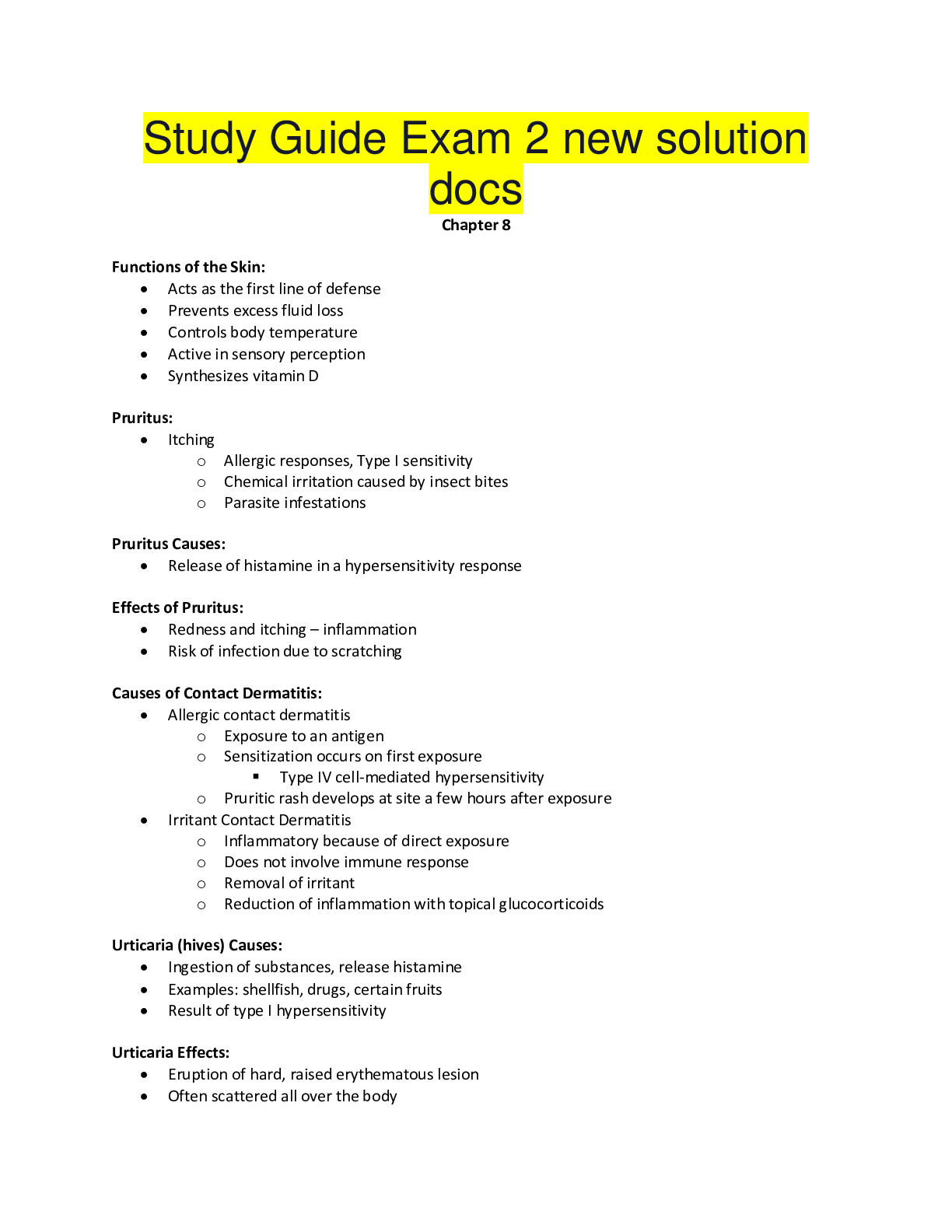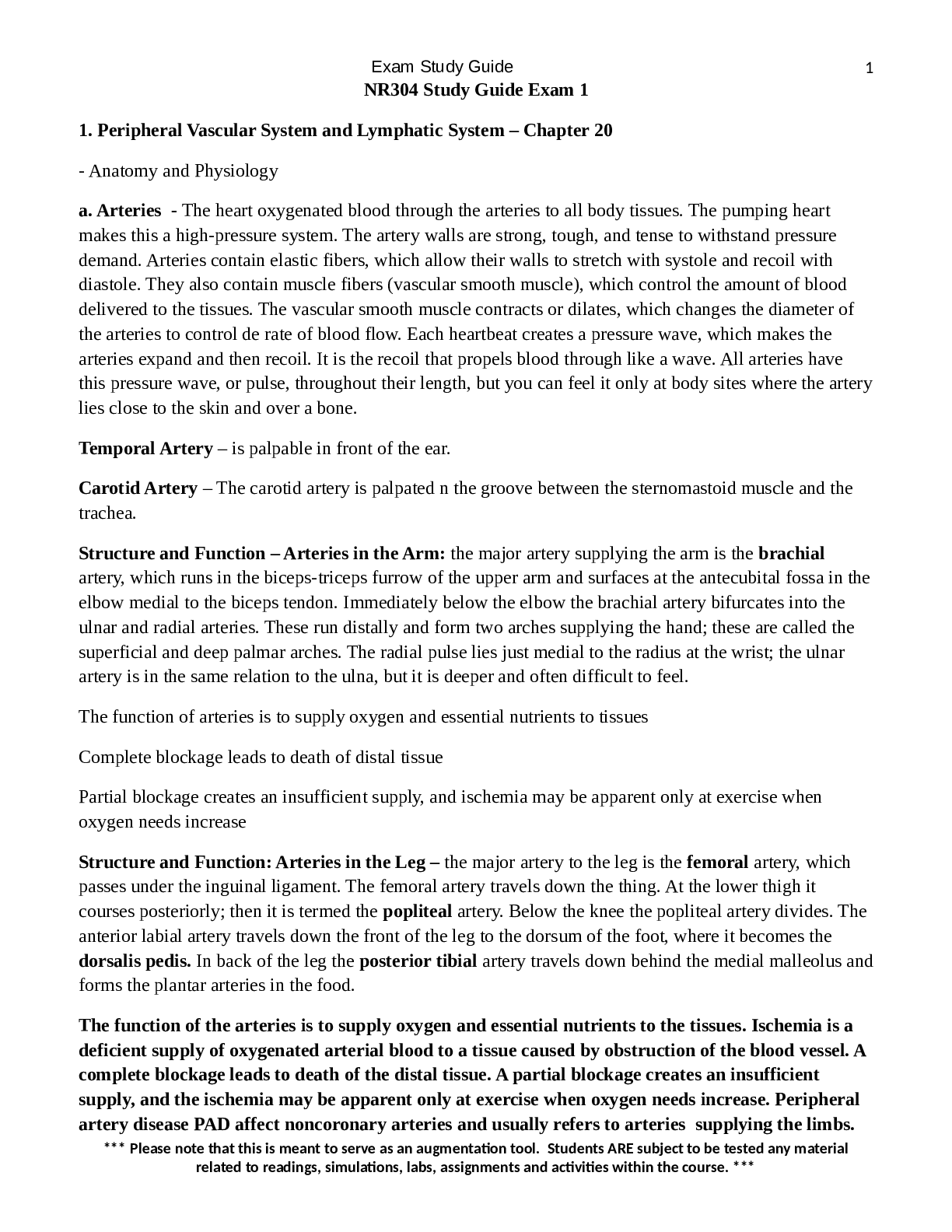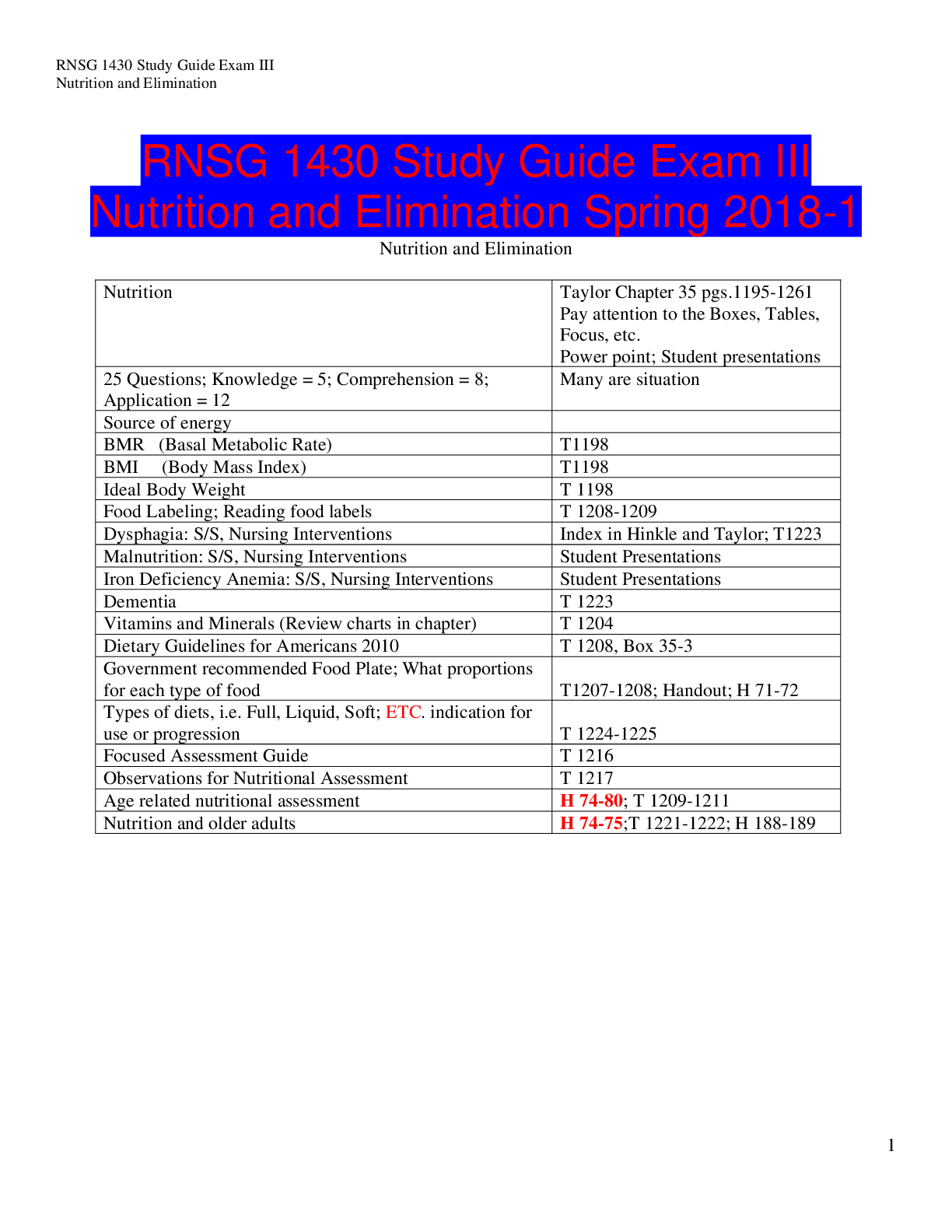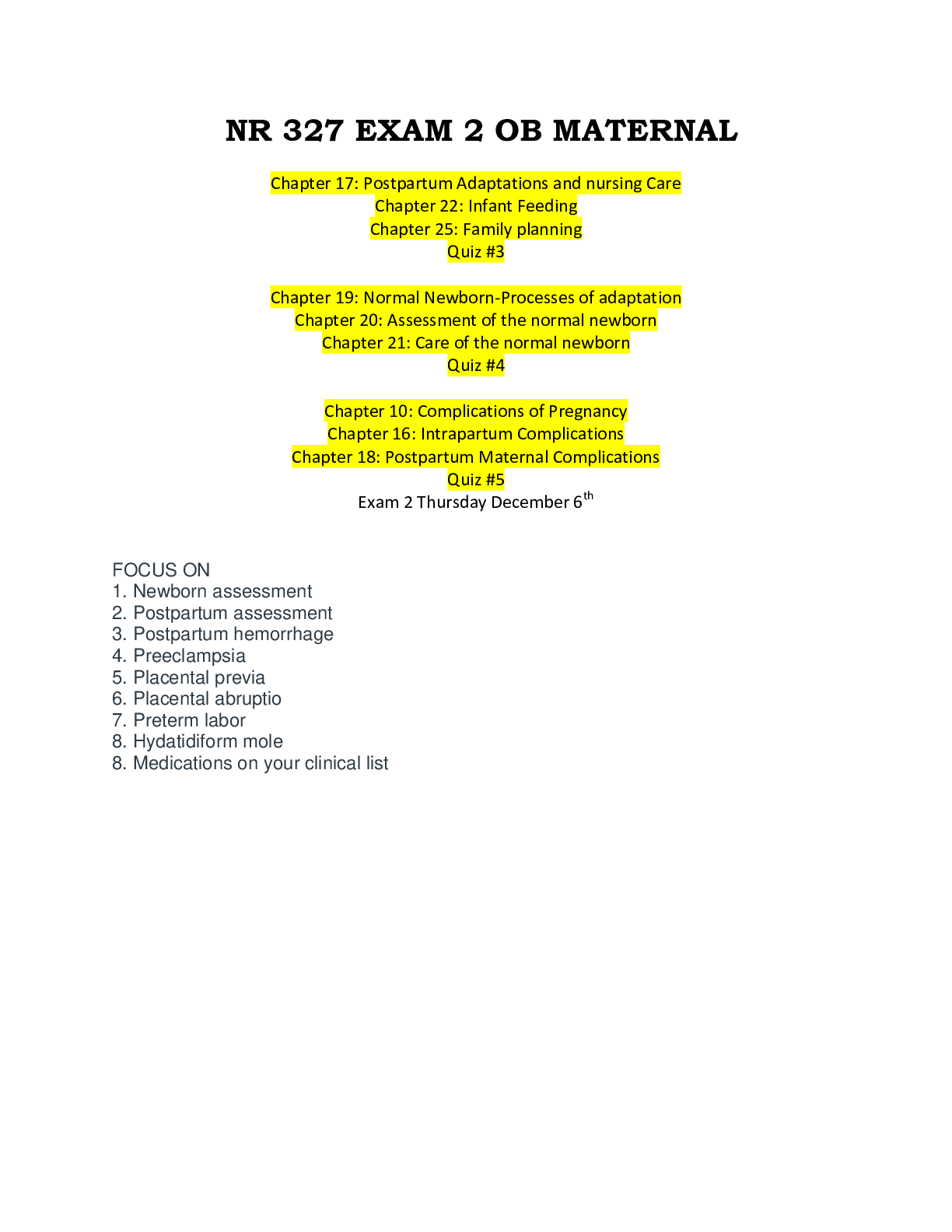*NURSING > STUDY GUIDE > NR 327 STUDY GUIDE EXAM 2 OB MATERNAL -Miriana,100% CORRECT (All)
NR 327 STUDY GUIDE EXAM 2 OB MATERNAL -Miriana,100% CORRECT
Document Content and Description Below
NR 327 STUDY GUIDE EXAM 2 OB MATERNAL -Miriana Chapter 17: Postpartum Adaptations and nursing Care Chapter 22: Infant Feeding Chapter 25: Family planning Quiz #3 Chapter 19: Normal Newborn-Pr... ocesses of adaptation Chapter 20: Assessment of the normal newborn Chapter 21: Care of the normal newborn Quiz #4 Chapter 10: Complications of Pregnancy Chapter 16: Intrapartum Complications Chapter 18: Postpartum Maternal Complications Quiz #5 Exam 2 Thursday December 6th FOCUS ON 1. Newborn assessment 2. Postpartum assessment 3. Postpartum hemorrhage 4. Preeclampsia 5. Placental previa 6. Placental abruptio 7. Preterm labor 8. Hydatidiform mole 8. Medications on your clinical list Chapter 17: Postpartum Adaptations and nursing Care Chapter 22: Infant Feeding Chapter 25: Family planning Quiz #3 • 4th stage of labor/Postpartum period/Puerperium • First 6 weeks after birth of infant o -Return of reproductive organs to normal nonpregnant state • Physiological maternal changes o Uterine involution Starts right after delivery of placenta Changes of reproductive organs, particularly the uterus that returns to non-pregnant size and condition • Involves three processes o 1. Contraction of muscle fibers o 2. Catabolism: the process of converting cells into simpler compounds o 3. Regeneration of the uterine epithelium Sub-involution: when uterus does not return to non-pregnant state, o lochia flow, cervical involution, o Decrease in vaginal distention o alteration in ovarian function and menstruation o Cardiovascular, urinary tract, breast and GI tract changes Afterpains: intermittent uterine contractions, source of discomfort for many women, the discomfort is more acute for multiparas because repeated stretching of muscle fibers leads to muscle tone loss that causes repeated contraction and relaxation of the uterus. • Greatest risks during postpartum period: hemorrhage, shock, and infection. • Oxytocin o Administer postpartum to improve the quality of uterine contractions. A firm and contracted uterus prevents excessive bleeding and hemorrhage • After delivery of the placenta, hormones decrease resulting in decreased blood glucose, estrogen and progesterone o Decreased estrogen causes breast engorgement, diaphoresis, and diuresis o Decreased vaginal lubrication Assessment • Monitor vital signs, uterine firmness and its location in relation to the umbilicus, uterine position in relation to the midline of the abdomen, and amount of vaginal bleeding • BP and pulse assessed every 15 mins for the first 2 hours after birth • Temperature every 4 hours for first 8 hours after birth and then at least every 8 hours Postpartum Assessment • Breasts • Uterus (fundal height, uterine placement, and consistency • Bowel and GI function • Bladder function • Lochia (color, odor, consistency, and amount (COCA)) • Episiotomy (edema, ecchymosis, approximation) Vital signs to include pain assessment and teaching needs RH Negative mothers • Rho(D) immune globulin is administered within 72 hours to women who are Rh-negative and gave birth to infants who are Rh-positive to prevent sensitization in future pregnancies. Kleihauer-betke test • Determines amount of fetal blood in maternal circulation if large fetomaternal transfusion suspected. If 15 ml or more of fetal blood detected, mom can get increased Rho(D) immune dose Thermoregulation • Postpartum chill occurs in first 2 hours puerperium o Uncontrollable shaking chill following birth o Nervous system response, vasomotor changes, a shift in fluids, and/or work of labor o Normal unless along with elevated temperature Interventions: Provide warm blankets and fluids Assure client that chills are self-limiting Fundus Physical changes include involution of the uterus Uterus decreases in size from 1 kg to 60 to 80 g at 6 weeks with fundal height into pelvis at one fingerbreadth per day • At end of 3rd stage of labor, uterus palpable at midline and 2 cm below to halfway between umbilicus and symphysis pubis. • 1 hr after, fundus rise to level of umbilicus • Every 24 hour, fundus should descend 1-2 cm. halfway between the symphysis pubis and umbilicus by 6th postpartum day • After 2 weeks, uterus should lie within true pelvis and should not be palpable Assessment Assess fundal height, uterine placement, and uterine consistency at least every 8 Hr after recovery period ended Cup one hand just above symphysis pubis to support lower segment of uterus and palpate abdomen to locate fundus with other hand Document fundal height Midline or displaced If displaced, due to full bladder Firm or boggy (not firm) If boggy, lightly massage the fundus in a circular motion Patient-Centered Care • Administer oxytocics (oxytocin, methylergonovine and carboprost) IM or IV after placenta to promote uterine contractions and to prevent hemorrhage • Encourage emptying of bladder every 2 to 3 hours to prevent possible uterine displacement and atony Lochia Post-birth uterine discharge that contains blood, mucus, and uterine tissue Rubra: bright red color, dark red or brown color, blood consistency, fleshy odor, can contain small clots, transient flow increases during breastfeeding and upon rising, lasts 1-3 days after delivery Serosa: pinkish brown color and serosanguinous consistency. Lasts from day 4 to day 10 after delivery Alba: yellowish white creamy color, fleshy odor, lasts from day 11 up to 4 to 8 weeks Postpartum Rub for 3 days, sir has six alibis and on Rubra (3 days), serosa (6 days), alba Assessment Lochia amount assessed by pad Scant: less than 2.5 cm Moderate: more than 10 cm Heavy: one pad saturated within 2 hours Excessive blood loss: one pad every 15 mins or less Lochia trickles from vaginal opening and steadily during uterine contractions Abnormal lochia manifestations: excessive spurting of bright red blood from vagina possibly indicating a cervical or vaginal tear -foul odor Cervix, vagina, and perineum • Physical changes: o cervix: Shortens, gradually OS closing o Vagina distended returns to prepregnancy size with reappearance of rugae and thickening of vaginal mucosa. o Dyspareunia: discomfort during intercourse o Soft tissues of perineum can be erythematous and edematous o Episiotomy: check for approximation, drainage, quantity, and quality Bright red trickle of blood from the episiotomy site in the early postpartum period is a normal finding Client should clean her perineal area from front to back Blot dry not wipe Provide comfort measures: Apply ice packs to the client’s perineum for first 24-48 hours to reduce edema Encourage sitz baths at temperature of 38 degrees Celsius to 40 Apply topical anesthetics to the clients perineal area as needed or witch hazel compresses to rectal area for hemorrhoids Breasts: Secretion of colostrum 2-3 days Redness and tenderness of breast Cracked nipples and indications of mastitis Cardiovascular system and fluid and hematologic status Blood loss during childbirth (average blood loss is 500 ml in an uncomplicated vaginal delivery and 1000 ml for a cesarean birth) hypovolemic shock does not occur in response to normal blood loss of labor and birth physical changes in blood values, coagulation factors and puerperium increased HCT and HGB values present immediately after delivery Vital signs Blood pressure is unchanged with uncomplicated pregnancy Possible orthostatic hypotension within first 48 hours Elevation of pulse, stroke volume, cardiac output for first hour postpartum then gradually decreases Elevation of temperature to 38 degrees celsius resulting from dehydration after labor during the first 24 hour may occur but should return to normal after 24 hour postpartum. Urinary system Loss of bladder elasticity and tone or loss of bladder sensation resulting from trauma, medications, or anesthesia o Distended bladder as a result of urinary retention can cause uterine atony and displacement to one side, usually to the right. Ability of uterus to contract is also lessened o Assess client’s bladder elimination pattern, voiding every 2-3 hr Excessive urine diuresis 1500 to 3000 ml/day is normal within first 2-3 days • Assess for evidence of a distended bladder o Fundal height above umbilicus o Fundus displaced from midline over to side o Bladder bulges above symphysis pubis o Excessive lochia o Tenderness over bladder area o Frequent voiding of less than 150 ml of urine is indicative of urinary retention with overflow Musculoskeletal system • Feet may remain permanently increased in size • Rectus abdominis muscles of abdomen and pubococcygeal muscle tone are restored following placental expulsion and return to prepregnant state within 2-6 weeks postpartum o Teach client postpartum strengthening exercises, advising her to start with simple exercises and then gradually progressing to more strenuous ones o If C section, restrain abdominal exercises until 4 weeks Immune system Rubella status: client titer 1:8 Do not get pregnant for one month following immunization Review hepatitis B status If newborn infected with HEP B, receive hep B vaccine and hep B immune globulin within 12 hour of birth Review Rh status All Rh negative mothers who have newborns who are RH positive must be given rhogamadminisitered IM within 72 hour of the newborn being born to suppress antibody formation in mother Test client after 3 months of receiving rubella and rhogam to determine if immunity to rubella has developed Review varicella status if client has no immunity varicella vaccine is given before discharge should not get pregnant for one month following immunization second dose of vaccine given at 4-8 weeks Review tetanus diphtheria acellular pertussis vaccine status- the vaccine is recommended for women who have not previously received the vaccine. Administer prior to discharge or as soon as possible in the postpartum period Weight loss: 4.5 to 5.8 kg is lost during childbirth Greatest loss during first 3 months Assessing the uterine fundus The uterus can continue to contract only if it is free of intrauterine clots To expel the clots, the nurse should massage the fundus until firm and then support the lower uterine segment oxytocin is used to prevent postpartum hemorrhage Psychosocial adaptations RUBIN:post partum: Taking in phase: the mother is focused on her own need for fluid, food, and sleep. Major task for mom is to integrate her birth experience into reality. Lasts 1-2 days Taking-Hold Phase: Managing her own body functions and assumes responsibility for her own care. Mother may verbalize anxiety about her competence as a mother -Good time for nurse to teach Letting-Go Phase: Couple must give up their role as a childless couple and acknowledge the loss of their more carefree lifestyle. In addition, some mothers and fathers are disappointed in the size, gender, and characteristics of the infant who does not match up with the fantasy baby of pregnant Maternal Role Attainment Mother achieves confidence in her ability to care for her infant and becomes comfortable with her identity as a mother Anticipatory stage, formal stage, informal stage, personal stage END POINT: becoming a mother Postpartum blues: begins in first week and usually lasts from a few days to up to 2 weeks. Characterized by insomnia, irritability, fatigue, tearfulness and mood instability and anxiety Engrossment: the developing bond between a father and newborn. Characterized by intense interest in how the infant looks and responds, along with a desire to touch and hold the baby. Interventions: Mother the mother Provide ample fluids and favorite foods Monitor and Protect Remind her of the need to void and assist her to ambulate Assist the parents in unwrapping the baby to inspect Position the infant in an en-face position: face to face, eye to eye Model behaviors Hold infant close, make eye contact with the infant and speak in high pitched soothing tones Point out the characteristics of the infant in a positive way Infants must be fed every 2-4 hours, and will not sleep through the night for 12-16 weeks In class notes: Chapter 17 Reproductive system: Uterine involution Contraction of muscle fibers Regeneration of uterine epithelium Breast feeding can be used as a birth control Uterine descent: Immediately after delivery Every 24 hours descends 1 cm, if breast feeding, oxytocin released naturally by day 10 not palpable Afterpains: intermittent uterine contractions Loss of muscle tone Overdistention Breastfeeding Overstretching causes more pain Nursing: use analgesics for pain (motrin because of anti- inflammatory response, encourage early ambulation but Monitor for weakness and dizziness first -use of narcotic results in constipation Cervix: At one week cervix is firm and external os 1 cm and slit-like Vagina Mucosa atrophic until estrogen production is reestablished 6-10 weeks for vaginal epithelium to be restored Perineum-REEDA Episiotomy heals in about 2-3 weeks Lacerations- same healing time but may have less discomfort Cardiovascular system Elimination from placenta More blood back in circulation Increased blood flow from release of pressure on vena cava Mobilization of body fluids from pregnancy= needs to get out! Diuresis: peeing a lot 150 ml of urine every void Diaphoresis Decrease swelling, first ice to decrease swelling then heat to promote circulation Blood values: WBC up to 30,000 Hgb/Hct return to normal 4-6 weeks after delivery Coagulation factors remain high for several days to several weeks Encourage movement GI system Mom gets hungry and thirsty, constipation is common problem = increase grains fiber, water, increase ambulation to increase peristalsis Urinary system Kidneys return to normal function within 4 weeks post birth Musculoskeletal Abdominal wall weakens and muscle tone weakens, muscle separates Takes 4-6 weeks to come together Increases risk for umbilical hernia Nursing intervention: avoid extension in beginning Integumentary Significantly reduced or disappear Neuro Anesthesia and or analgesia may produce temporary changes Prevention of injury is a priority Carefully assess headaches Immune: Rubella 1:8 or less is not immune Give them after pregnancy Cannot get pregnant for one month Safe for nursing mothers Flu-like symptoms may occur Varicella (chicken pox) Live vaccine, do not give in pregnancy If mom is not immune, she needs it Tdap Highly recommended in 3rd trimester Immune to whooping cough (pertussis) Vital Signs In first 24 hours: Temperature up to 100.4 may occur from dehydration BP: stable Hypovolemia: indicates postpartum hemorrhage Hypervolemia: preeclampsia and HTN Pulse: 50-70 bradycardia is normal Tachycardia not normal and can indicate hemorrhage Respirations: 12-20 Skin: pink and appropriate for ethnicity Not cool and clammy Location of uterus and if firm is highest priority Every 15 mins Look at color Rubra is 1-3 days Serosa 4-11 Alba 11 on RUB SEROSA ALL one four eleven Assess perineum Breasts, uterus, bowel, bladder, lochia, episiotomy/laceration/incision, thrombus/thromboembolism/thrombophlebitis, emotions, Rhogam/Rubella as indicated Do heart and lungs auscultate, then auscultate bowels and then BUBBLE Breasts: Look for symmetry, consistency and nipple condition Full, soft, engorged Nipple condition: inverted, everted, flat, compressed or retractable Assess how they breastfeed Mastitis occurs 2 weeks after Express colostrum-- like milking a cow Uterus Firm, boggy? We want it firm at all times If uterus is boggy, support lower uterine segment and massage If uterus above umbilicus, this indicates bladder distention So have patient void or catheterize her If soft, uncontracted when massage stops Support lower uterine segment, massage until firm and express any clots If bladder no distended, may indicate clots C-section we still palpate the uterus, just be a little more gently Bowel Have you had a bowel movement Hypoactive, hyperactive, normoactive bowel sounds in all four quadrants We don’t want them bearing down Bladder If patient urinating, still push on bladder to make sure all emptied Void within 6-8 hours Lochia Assess if bleeding too much Episiotomy/laceration/incision Ice on for 20 min and 20 min off Lidocaine numbing spray Positioning-donuts Perineal hygiene, clean front to back After 48 hours we do heat Sitz bath promotes healing by increasing circulation by vasodilation, check heart rate to check Tolerance Witch hazel pads cold Laceration degrees= higher degree is more painful Episiotomy: healthcare provider makes the incision, could be midline or can go into the Labia Lacerations- 1st to 4th degree Incisions: if obese, the C section incision can cause dehiscence T3: thrombus, thromboembolism, thrombophlebitis C-sections Complete previa Active genital herpies Placental abruption Baby too big Failure to progress/dilate Contraindications: baby is dead there is no rush Homan’s sign: on exam positive homans = positive DVT Emotions Have you ever felt like hurting your baby Post partum blues Only normal for first 2 weeks Then becomes post partum depression Interventions: support mom, answer Q, reassurance, Taking in phase Wants to talk about pregnancy Provide care, review Taking hold phase Dependent/independent phase, starts day 2-3 Mom focusing on baby care, asking Qs, how do I change the baby How do I feed the baby, she wants to take care but she doesn’t know How, so she is trying to learn Baby blues may occur Give community resources Assess emotional status Letting go phase Interdependent phase Assess her progress, how is she moving alone Weight baby, weight mom, offer support Rhogam and Rubella When to call health care provider (typically missed on CMS) Fever, S/s breast infecton, pain should not worsens, persistent abdominal tenderness, pelvic fullness or pressure, persistent perineal pain, s/s UTI, abnormal change in lochia, S/S thrombi, S/S infection of incision For lochia: cant skip a step and can’t revert back to a step Rubra: Day 1-4 Bright red, fresh blood. Serosa: Day 4-10: Pink to brown Alba: Day 11-21: yellow to white. Soaking a pad in 1 hour or less is concerning. If fundus is soft, massage. If uterus is firm, its coming from some sortof internal or external source. Care management Handwashing Prevention of excess bleeding Maintenance of uterine tone If not breast feeding: tight supportive bra No hot showers because it promotes stimulation 11/27/18 Baby stomach is size of marble. They Only need 2-3 tbsp of colostrum Transitional milk-pale yellow white lasts up to 10 days Chapter 22: INFANT FEEDING • CALORIES: Full term newborn needs 100 to 110 kcal/kg of body weight each day • FLUID: o 40-60 ml/kg for the first 2 days of life o 100-150 ml/kg by the end of the first week • Changes in milk composition o Colostrum: 7-10 days after birth A thick yellow substance Higher in protein, fat soluble vitamins, and minerals than mature milk Colostrum helps establish the normal flora in the intestines o Baby stomach is size of marble. o They Only need 2-3 tbsp of colostrum o Transitional milk-pale yellow white lasts up to 10 days Benefits to breastfeeding for the infant o Allergies less likely to develop o Immunity prevents infections o Lower incidence of diabetes, SIDs, o Easily digested o Less likely to result in overfeeding o Constipation less likely: breast milk has a laxative effect to it Benefits to breastfeeding for the mother o Oxytocin release enhances uterine involution o Less blood loss o Resumption of ovulation is delayed o Decrease risk of cancer o Skin to skin o Convenient o Economical: free o Infant is less likely to be ill Formulas Modify cow’s milk to compare with breast milk Reduce protein content remove saturated fat Formulas for infants with special needs Soy/protein hydrolysate, protein hydrolysate Normal Breastfeeding • breast changes during pregnancy o Suckling of the infant transmits signal • milk production • hormonal changes at birth o prolactin: initiates milk production o oxytocin: helps with milk ejection • preparation of breasts Types of nipples: Everted nipples: IDEAL Flat nipples Inverted nipple Nursing care for breastfeeding • position of mother’s hands: C-cup • remove baby from nipple by putting finger in mouth to break the seal • Ideally, every 2-3 hours should feed. Go from the start time to start time. • Mom should not feel pain, shouldn’t feel pinching. • Have mom rub breast milk on nipple • Evaluate feeding based on wet diapers • Football positioning is good for mom’s with C-section • Baby has to have majority of areola on mouth Infant problems • Sleepy: wake them up by unswaddling them • nipple confusion • suckling problems • infant complications • jaundice • prematurity • illness and congenital defects Cabbage leaves Common breastfeeding concerns: Maternal Concerns • contraindicated medications: anticonvulsants • working moms that don’t know their rights Interventions to assist with breastfeeding -pumps -breast milk storage -shells -shields -SNS -seek assistance from a lactation consultant Chapter 25: Family Planning/Birth Control Nonhormonal Methods Natural Family Planning Diaphragm: ATI LIKES IT Cervical Cap: must be fitted, can stay in place for 6 hours after 6 Empty bladder prior Male/Female Condom: only birth control that protects against STDs Intrauterine Device: copper IUD- 10 years, periguard, have to check for monthly string Male/Female Sterilization: have to get vasectomy, but first has to ejaculate 20 times or more prior. All semen has to leave scrotal sac. Essure: a device for female sterilization. It is a metal coil which when placed into each fallopian tube induces fibrosis and blockage Hormonal Methods Intrauterine Device Oral Contraception: places patients at increased risk for MI Contraindicated in smokers, overweight, gall bladder, HTN, h/o DVTs, estrogen associated cancers Progesterone: makes you hungry Provera: makes you hungry & make sure intaking calcium Plan B taken 120 hours after sex Injectable/Implantable Contraception Emergency Contraception Let’s say shortest cycle is 26 days: subtract 18 days, get day 8th Longest cycle is 30 days: 30-11 get 19 FERTILE PERIOD IS 8-19 Chapter 19 Neonatal Transition Done at 1 minute and 5 minutes When 5 minutes is less than 7, then they do the 10 minute one APGAR SCORE (0, 1 or 2) Heart rate Respiratory Rate Muscle Tone Reflex irritability Color Rita has red toe color 0-absent Normal heart rate: 110-160 Respiratory rate Acrocyanosis: normal for 24 hours Initiation for Respirations Chemical factors: Decreased oxygen and increased carbon dioxide Thermal factors: Cool environment Mechanical factors Chest compression via vagina squeezing chest wall to push fluid out of alveoli C-section babies have wet lung sounds for first 24 hours of life Sensory Factors Handling, suctioning, lights/sounds/smell If baby has meconium stained fluid then we don’t stimulate them to cry Character of Newborns Respirations • In first 30 mins (time of reactivity) o May have tachypnea 60-70, some cyanosis and acrocyanosis, diaphragmatic o shallowIrregular depth and rhythm (periodic breathing) • Once established o Normal rate (30-60), chest movement (always symmetric), breath sounds o Babies are nose breathers so we suction their mouths before their nose M before N Cardiovascular Adaptation -At birth the ductus venosus, foramen ovale, and ductus arteriosus close and pulmonary vessels dilate Thermoregulation risks -Little adipose tissue, blood vessel location, larger body surface to weight ratio, skin is thin, methods of heat loss, non-shivering thermogenesis, brown fat, effects of cold stress, neutral thermal environment, hyperthermia -babies don’t shiver, if shivering, then hypoglycemic because its jittering -Brown fat should be broken down in emergency Methods of heat loss: • Evaporation • Conduction: by touch-stethoscope, hands, put barrier • Convection: air currents remove heat from the baby • Radiation: heat transferring from baby to something not in direct contact with the baby Cold Stress • Axillary temperature: 97.7-99.5 o Signs/symptoms Restless/crying Skin feels cool • Acrocyanosis/mottling o After 24 hours acrocyanosis is no longer normal • Hypoglycemia: when cold, we utilize glucose • Increased respirations: when cold, we use surfactant o May go into respiratory distress Hematologic Adaptation Blood values: erythrocytes and hemoglobin 15-24, hematocrit 45-65%, leukocyte 9100-34,000 then decreases to 12,000 by day 5 Risk of clotting deficiency Gastrointestinal system: Digestion Stools First stool no matter what is known as meconium Feeding behavior Signs of risk for GI problem GI responses to birth • Stomach • Cardiac sphincter • Bowel sounds • Meconium, transitional stools • Digestion o Simple carbs, fats, proteins, o Need 120 kcal/day Urinary: Urinate approximately 6 – 8/day 92% of infants void in first 24 hours Until 3 months old, newborn has limited ability to concentrate urine Fluid overload can occur easily Gastrointestinal system: Meconium accumulates in the intestines throughout gestation Meconium is green/black/ viscous/tar-like and is passed within the first 48 hours Stool characteristics indicate functioning of the GI tract-formula stool, breastfeeding stool, transitional stool Senses Vision: distance from infant’s face to mothers while feeding Vision – Visual acuity is equal to the distance from the infant’s face to mother’s face while feeding – Can distinguish patterns by as early as two weeks of age – By 6 months infants have the visual acuity of adults Hearing – When amniotic fluid drains from the ears, can hear as well as an adult – Startle Reflex – response to voices and sounds Taste – Can distinguish tastes based on facial reactions. Touch – Responsive to touch and needs for growth and development! – Habituation – psychological and physiological phenomenon where an infant “nests” into his/her environment Chapter 20: Assessment of the normal newborn 1. Breathing, heartrate, and thermoregulation Thermoregulation: Take temperature soon after birth Set warmer controls to regulate the amount of heat produced Reassess every 30 mins until stable 2. Look for anomalies 3. Airway: respiratory rate, breath sounds, signs of respiratory distress, choanal atresia (blocking of nasal passage) General assessment Head: fontanels, caput succedaneum, cephalohematoma Caput cuccedaneum: edema of the scalp Seen at birth, gone in 12-18 hours Cephalhematoma: accumulation of blood Does not cross suture line, not seen at birth Seen 1-2 days after birth and goes away 1-2 weeks Later IF blood, higher risk of jaundice Sutures usually overriding Assess fontanels with baby sitting up Fontanels should be soft and flat If bulging, then increased ICP If sunken, then dehydration Anterior fontanel: closes at 18 months Posterior fontanel: few weeks to couple months Face: eyes symmetrical and lined up Eyes to ears: imaginary line straight across to top of ears, if not straight then down Syndrome Eyes: pearly gray Conjunctiva: pink Mouth: sucking rooting while you’re there Palpate the tongue Check for teeth Check for epstein pearls: whitish-yellow cysts that form on the gums and roof of the mouth in a newborn baby Head: circumference Neck and clavicles Run fingers down trachea, palpate the clavicles looking for crepitus and symmetry Chest: rise and fall should be symmetrical Nipples: 2 present Abdomen: umbilical cord clamped or unclamped Dry or wet Do abdominal circumference for baseline Anogenital Extremities Vertebral column Reflexes: moro reflex, plantar grasp reflex, Babinski reflex, palmar grasp reflex, rooting reflex, tonic neck reflex, stoopling reflex, sucking reflex, Measurements: weight, length, head, chest Reproductive system Female: Increase in estrogen during pregnancy with decrease in estrogen after birth = mucoid vaginal discharge and pseudomenstruation External genitals – labia major and labia minor are edematous Male: Testes down to scrotum by birth Deep rugae and pendulous scrotum Breast tissue of both sexes – hyperestrogenism of pregnancy = swelling in breast tissue and “witches” milk Integumentary: Lanugo, vernix casseosa, milia (little white pimples on nose), erythema toxicum Mongolian spots, telangiectatic nevi (Red spot in back of head), nevus flammeus (strawberry birth mark) Newborn Assessment Terms AGA = 10 – 90% SGA = < 10% LGA = > 90% IUGR Preterm/Premature = < 34 weeks gestation Late Preterm=34 to 36 6/7 weeks gestation Term = 38 to 42 weeks gestation Post Term (postdates) = > 42 weeks gestation Postmature = > 42 weeks of gestation with evidence placental insufficiency. Posture in newborn needs to be legs flexed and arms too, square window sign (if square window with wrist then baby is preterm) arm recoil, popliteal angle, scarf sign, heel to ear, plantar creases, breast bud measurement, Chapter 21: care of the newborn Early care medications Vitamin K administration Eye prophylaxis Immunizations Ongoing Assessments and Care Assess every 8 hours Provide skin care Bathing Cord care Cleansing the diaper area Feedings Positionings Protecting the infant Sudden infant death syndrome Crib Sleeping Sleep sack Tummy time Smoking Newborn labs and screening tests Bilirubin Blood glucose PKU Critical congenital heart defect Hearing screen Pain in Neonates: Nonpharmacologic management – Containment (swaddling) – Nonnutritive sucking – Distraction: visual, oral, auditory, tactile – Sucrose: Sweet-Ease Circumcision Care Preop Postop Gomco Vaseline Gauze Plastibell Complications Healing Complications in Pregnancy Gestational Hypertension • BP elevation greater than 140/90 after 20 weeks of pregnancy (two times reported within 4-6 hours apart within a 1 week period) • No proteinuria/trace proteinuria • A working diagnosis- may progress to preeclampsia • Returns to normal within 4-6 weeks postpartum • Associated with placental abruption, kidney failure, hepatic rupture, preterm birth, and fetal and maternal death Preeclampsia Mild V. Severe • Mild: o episodes of transient headaches, only cure is to deliver the baby o Monitor compliance o Try to accelerate lung maturity o Home care: maintain bedrest o Encourage side lying position o Avoid high sodium diet o Increase water intake to 8 glasses/day o Maintain quiet environment to reduce stimuli o Maintain patent airway o Urinalysis Urine dipstick or a 24 hour urine protein o Fetal assessment: Fetal kick counts 2x/week for NST o Diet: o Protein and calories o Increase fluids 48-96 oz o 60-70 grams of protein Severe preeclampsia o BP 160/100 o Proteinuria 3+ o Bedrest o Oliguria o Cerebral or visual disturbances: HA or blurred vision o Hyperreflexia which is positive ankle clonus o Peripheral edema o Hepatic dysfunction o Epigastric pain o Thrombocytopenia Risk factors for preeclampsia/GH o Younger than 20, older than 40 o Family hx of preeclampsia o RH incompatibility o Morbid obesity o Diabetes o Chronic HTN o Multifetal gestation Inpatient management of severe preeclampsia o Assessment of patient: o Daily weights (5 pounds in one day) o Vital signs: BP to determine worsening condition o Breath sounds: respiratory depression and risk for pulmonary edema o DTR: loss of DTR, worsening headaches, epigastric pain, visual problems, n/v o Bedrest with some bathroom privileges o Antihypertensive medications: labetalol IV which can cause diuresis and nifedipine o Anticonvulsant medications o Magnesium sulfate: CNS depressant , antidote calcium gluconate o If mag toxicity, will have diminished DTR (3-4), worsening pounding HA, visual disturbances, decrease oncotic pressure leads to leaky capillaries leading to edema If given mag sulfate: 2 nurse check, lung assessment, DTR Q hour, give bolus of mag first, hand grasp QH, BP QH, LOC QH, urinary output because if holding on to magnesium then may have magnesium toxicity CLONUS IS ALWAYS BAD Oliguria means less than 500 H emolysis E: elevated Liver enzymes L ow Platelets Hemolysis: resulting in anemia and jaundice EL: elevated liver enzymes resuting in elevated ALT or AST, epigastric pain, and n/v. LP: resulting in thrombocytopenia (platelets less than 100,000), abnormal bleeding and clotting time, bleeding gyms, petechiae, and possibly DIC Chronic hypertension o GH and chronic hypertension can occur at the same time o BP is elevated even after pregnancy o And BP has always been high before 20 weeks Eclampsia o When there is onset of seizure or coma o Signs of eclampsia occurring are: HA, severe epigastric pain and hyperreflexia Anticonvulsant: o Magnesium sulfate Antihypertensive Medication o Methyldopa (Aldomet) o Nifedipine (Procardia) o Hydralazine o Labetolol o Metoprolol o Avoid ACE inhibitor and Ang II receptor blocker (-PRIL ENDING) o But you can use them postpartum Antepartal hemorrhagic disorders Early pregnancy bleeding 1. Abortion 2. Ectopic pregnancy 3. Gestation trophoblastic disease Late pregnancy bleeding 1. Placenta previa 2. Placenta abruption Abortion o Termination before 20 weeks and the fetus is 500 grams o Within a spontaneous abortion (there are types) o Threatened o Inevitable o Complete o Incomplete o Reoccurring o Spontaneous RF for spontaneous: chromosomal abnormalities, type 1 diabetes, older moms, advanced maternal age, maternal malnutrition, substance abuse Assessment: o Backache and abdominal tenderness o Rupture of membranes, dilation of cervix o Fever o Signs and symptoms of hemorrhage such as hypotension and tachycardia Therapeutic managements Lab tests: Hematocrit and hemoglobin low WBC: high for suspected infection Serum HCG to confirm pregnancy Clotting factor monitored for DIC o Ultrasound to determine if the fetus is fully gone o Check if HCG levels are decreased o Education- see a chromosomal specialist o Dilation and curettage (D&C): to dilate and scrape the uterine walls to remove uterine contents for inevitable and incomplete abortions o Dilation and evacuation (D&E): to dilate and evacuate uterine contents after 16 weeks of gestation o Prostaglandins and oxytocin to augment to induce uterine contractions to expel the products of conception Nursing considerations: o Use miscarriage term with patient not abortion o Observe color and the amount of bleeding, counting pads o Perform pregnancy test o Maintain client on bedrest o Assist with ultrasound o Determine how much tissue has passed and save tissue for examination o Medications: o prostaglandin (dinoprostone)-administered into the amniotic sac or as a vaginal suppository o oxytocin o broad spectrum antibiotics only for septic abortion o RHOGAM for suppression of immune system for clients who are RH negative Discharge instructions o Notify provider if heavy bright red bleeding elevated temperature, over 100.4, foul smelling vaginal discharge o Small amount of discharge is normal for 1-2 weeks o Refrain from tub baths, sex, placing anything inside the vagina for 2 weeks o Avoid becoming pregnant for two months Ectopic Pregnancy o Pregnancy occurring anywhere outside the uterus (usually fallopian tube) o Can cause infertility o Second most frequent cause of bleeding in early pregnancy RF o STIs, tubal surgeries, IUD Assessment o Stabbing pain on one side in lower abdominal wall o Missed period, positive preg test, vaginal spotting, cullen’s sign, low HCG levels o Referred shoulder pain due to peritonitis o Report of faintness and dizziness related to bleeding o Delayed 1-2 weeks period o Signs of hemorrhage and shock o Lab tests: levels of progesterone and HCG elevated rules out ectopic pregnancy Diagnostic and therapeutic procedures o Transvaginal ultrasound showing no fetus in the uterus o Salpingostomy o Methotrexate: inhibits cell division and embryo enlargement, dissolving the pregnancy Nursing action: Replace fluid and electrolyte imbalance Psychological support Liver and renal function studies, type and RH, CBC Client education: If pt prescribed methotrexate: avoid alcohol and folic acid because it will become toxic Protect yourself from the sun Gestational trophoblastic disease (Hydatidiform mole, choriocarcinoma, and molar pregnancy) o GTD is the proliferation and degeneration of trophoblastic villi in placenta becomes swollen fluid filled and takes the appearance of grape-like clusters o Embryo fails to develop beyond a primitive stage, associated with cancer o In complete mole, all genetic material is paternally derived Ovum has no genetic material Complete mole contains no fetus, placenta, amniotic membranes or fluid There is no placenta to receive maternal blood, hemorrhage into the uterine activity occurs and vaginal bleeding happens o Partial mole Contains abnormal embryonic or fetal parts, an amniotic sac, and fetal blood, but congenital anomalies are present Risk factors: Low carotene or animal fat intake Age- early teens or over age 40 Ovulation stimulation with clomiphene (clomid) Assessment: Seems normal pregnancy, but no baby only cysts Hyperemesis gravidarum: excessive vomiting due to elevated HCG levels Rapid uterine growth Bleeding is dark brown resembling prune juice or bright red that is either scant or profuse and continues to Sx of preeclampsia occur prior to 24 weeks of gestation Lab tests: HCG persistently high with expected decline after weeks 10-12 pregnancy Diagnostic and therapeutic procedures o Ultrasound reveals a dense growth with characteristic vesicles but no fetus in utero o Suction curettage is done to take everything out (the mole) o Following mole evacuation, pelvic exam and US of abdomen o Serum HCG after the molar pregnancy weekly for three weeks, then monthly for 6 months up to a year Patient Centered Care: Measure fundal height Assess vaginal bleeding and discharge Assess GI status and appetite Monitor for s and sx of preeclampsia Advise client to save clots and tissue for evaluation Administer meds o RHOGAM o Chemo for choriocarcinoma Avoid pregnancy for one year Important: follow up with provider and use reliable contraception * Placenta Previa Implant in lower uterine segment 3 types o Marginal: placenta is implanted in lower uterus but its lower border is greater than 3 cms from internal cervical os o Partial: lower border of placenta is within 3 cm of internal cervical os but does not full cover it o Total (the WORST): placenta completely covers cervical os Risk factors: Previous uterine scarring Previous C section Curratage Endometritis Multiple fetal gestation Being older than 35 Assessment: Painless bright red vaginal bleeding during 2nd and 3rd trimester Uterus is soft, nontender with normal tone, fetus in breech, oblique or transverse position Vital signs within normal limits Decreased urinary output will be a better indicator of blood loss Lab tests: HGB and HCT for blood loss assessment, CBC, blood type and RH, kleihauer-betke test (detects fetal blood in maternal circulation), coagulation profile Diagnostic Transabdominal or transvaginal ultrasound for placement of the placenta Fetal monitoring for fetal well being Patient centered care: Look at the fundal height Leopold maneuver No vaginal exam Assess for bleeding, leakage, or contractions Administer IV fluids, blood products, and medications as prescribed o Corticosteroids such as bethamethasone (celestone), promote fetal lung maturation if delivery is anticipated (cesarean birth) o Have oxygen equipment available Health promotion and disease prevention Bed rest, nothing inserted vaginally Placenta Abruption Occurs after 20 weeks gestation, third trimester, results in death, leading cause of maternal death Coagulation defect, such as DIC associated with it placenta detaches from the fetus o marginal: with external bleeding o partial: with concealed bleeding o complete: with concealed bleeding Risk Factors maternal hypertension trauma cocaine use anything resulting in vasoconstriction cigarette premature rupture of membranes multifetal pregnancy Assessment sudden onset of intense localized uterine pain with dark red vaginal bleeding area of uterine tenderness may be localized or diffuse over uterus and boardlike fetal distress signs of hypovolemic shock contractions with hypertonicity Laboratory tests: Hgb and Hct decreased Coagulation factors decreased Clotting defects (DIC) Cross and type match Kleihauer-betke Diagnostics BPP for fetal well being Ultrasound for fetal well being and placenta Nursing actions: Leopold maneuver Palpate for tenderness and tone Assess FHR pattern Administer IV fluids, blood products, and medications as prescribed, Corticosteroids Administer oxygen 8-10 L/min via face mask Assess urinary output and monitor fluid balance Hyperemesis Gravidarum Too much vomiting bc of high HCG level Results in 5 % weight loss Causes fluid and electrolyte imbalance Acetonuria and ketosis Risk factor: Younger than 20, obesity, first pregnancy, multifetal gestation, gestational trophoblastic disease, hyperthyroidism, high levels of emotional stress Patient centered care Have client remain NPO for 24-48 hours Assess turgor and mucous membranes Give client IV fluids or LR for hydration Urinalysis Give B6 Electrolyte balance Metoclopramide Ondansetron Corticosteroids Cervical insufficiency Incompetent Cervix Premature dilation of cervix Cerclage cervix sutured Collaborative care o Antibiotics o Rhogam if indicated o Emotional support Incompatibility between maternal and fetal blood • Rh incompatibility Risk factors Pathophysiology Fetal/neonatal implications Prenatal assessment/management Postpartum management • ABO incompatibility Diabetes in pregnancy Impaired tolerance of glucose with first onset or recognition during pregnancy 70-110 ideal DM may disappear after delivery People can develop diabetes within 5 years of that pregnancy Effects of GD Spontaneous abortion Infection Hydramnios, which can cause overdistention of the uterus, PROM, preterm labor, and hemorrhage Ketoacidosis Hypoglycemia from overdosing in insulin Hyperglycemia which can causes BIG BABIES Risk Factors Older than 25, family hx, previous delivery of stillborn or large baby, obesity Assessment: Hypoglycemia (nervousness, headache, irritability, hunger, blurred vision, tingling of mouth or extremities Hyperglycemia: Thirst, nausea, abdominal pain, fruity breath, frequent urination, flushed dry skin) Physical: Hypoglycemia Shaking Clammy pale skin Shallow respirations Excessive weight gain during pregnancy Lab test: Routine urinalysis with glycosuria Glucola screening test/1 hour glucose tolerance test (50 g oral glucose load, followed by plasma glucose analysis 1 hr later performed at 24-28 weeks of gestation) + test is 130-140 or greater OGTT Glucola screening test performed at 24-28 weeks 50g 1 hr. OGCT (>140mg/dL is positive for GD) GDM diagnostic test 3-hour, 100g OGTT fasting: ≤95mg/dL 1 hour: ≤180mg/dL 2 hour: ≤155mg/dL 3 hour: ≤140mg/dL Presence of ketones in urine is tested to assess the severity of ketoacidosis Diagnostic: BPP Amniocentesis with alpha fetoprotein Nonstress test Patient centered care: Administer insulin Most oral hypoglycemic agents are contraindicated for GD DM but there is limited use of glyburide at this time Client education Instruct client to perform daily kick counts Educate client about diet and exercise Instruct client about self admin of insulin Preexisting diabetes mellitus Maternal Effects 1st trimester SABs; fetal malformations preeclampsia risk UTIs Ketoacidosis Fetal Effects Congenital malformation if glucose not controlled Hydraminos Macrosomia or SGA (due to vascular impairment) IUGR Neonatal Effects Hypoglycemia Hypocalcemia Hyperbilirubinemia Respiratory distress syndrome History Physical examination Laboratory tests-renal function & glycemic control Fetal surveillance Therapeutic management-normal blood glucose levels, healthy baby, avoid impairment of blood vessels and major organs Preconception care Diet-registered dietician Self-monitoring of blood glucose Insulin therapy First trimester Second and third trimester Labor Postpartum Timing of delivery Cardiac diseases in pregnancy Heart disease complicates about 1% of pregnancies. It remains a significant cause of maternal mortality. The two major categories of heart disease are rheumatic heart disease and congenital heart disease. Peripartum Cardiomyopathy Complicates less than 1% of pregnancy Development of CHF in the last month of pregnancy or within the first 5 months postpartum with lack of another cause for CHF and absence of heart disease before the last month of pregnancy Symptoms Dyspnea Edema Weakness Chest pain Heart palpitations Syncope with exertion Therapeutic Management Limit physical activity Avoid excessive weight gain Prevent anemia Prevent infection Ongoing assessment for CHF, pulmonary edema, cardiac dysrhythmias Medical Management Anticoagulants Antidysrhythmics Antibiotics Sodium Restriction Fluid Restriction Diuretics Intrapartum management Minimize effects of labor on cardiovascular system Intrapartum: careful management of IV fluids, position client on her side with head and shoulders elevated, administer oxygen, reduce pain, decrease anxiety Drug therapy: Heparin= ok, Coumadin= no Digoxin, adenosine, and calcium channel blockers are safe. Antibiotic prophylaxis to prevent endocarditis Vaginal delivery recommended Postpartum monitoring: monitor for thromboembolism, cardiac decomposition, infection, hemorrhage, urine output Cardiac Disease: Postpartum Management (Cont.) Signs and symptoms of congestive heart failure include: Cough (frequent, productive, hemoptysis) Progressive dyspnea with exertion Orthopnea Pitting edema of legs and feet or generalized edema of face, hands, or sacral area Heart palpitations Progressive fatigue or syncope with exertion Moist rales in lower lobes, indicating pulmonary edema Anemia Most common medical disorder of pregnancy Iron deficiency Folic acid deficiency Sickle cell Normal pregnancy changes may bring on more crisis Thalassemia 1st & 3rd trimesters Hgb <11 g/dl 2nd trimester Hgb < 10.5 g/dl Medical Conditions in Pregnancy Asthma Hypothyroidism Risk for SAB, preterm birth, low birth weight, preeclampsia Immune disorders Systemic lupus erythematosus (SLE) Antiphospholipid syndrome (APS) Hasimoto’s thyroiditis Rheumatoid arthritis Neurologic disorders- Seizure disorders Bell’s palsy Substance Abuse During Pregnancy Infections HIV/AIDS TORCH Beta strep Chlamydia Gonorrhea Candida albicans HIV/AIDs RF IV drug use Multiple sex partners Bisexuality Maternal history of multiple STIs Blood transfusion (rare occurrence) Assessment: Fatigue and influenza like symptoms Objective date: Diarrhea and weight loss Lymphadenopathy and rash Anemia Laboratory tests Informed consent prior to testing (testing begins with antibody screening test such as enzyme immunoassay, confirmation of positive results is confirmed by western blot test or immunofluorescence assay Use rapid HIV antibody test (blood or urine sample for a client in labor Screen client for STIs such as gonorrhea, chlamydia, syphilis, and hep B Teamwork and Collaboration Nursing care Provide counseling prior to and after testing Use standard precautions Administer antiviral prophylaxis, triple drug antiviral, or highly active antiretroviral therapy (HAART) Encourage vaccination against hep B, pneumococcal infection, H influenzae type B and viral influenza Encourage condom use Review plan for c section if maternal load of more than 1000 copies/ml Infant should be bather after birth before remaining with mom Medication Retrovir (zidovudine) Nucleoside reverse transcriptase inhibitor Nursing considerations Administer Retrovir at 14 weeks of gestation throughout preg before onset of labor Admin Retrovir to the infant at delivery and for 6 weeks following birth Client education Instruct client not to breastfeed Discuss HIV and safe sexual relations with the client Refer client and infant to providers specializing in the care of clients who have HIV TORCH INFECTIONS Acronym for Toxoplasmosis, Other include hep a and b, syphilis, mumps, parvovirus b19, and varicella zoster, Rubella, Cytomegalovirus, and herpes Subjective data Toxoplasmosis: similar to influenza or lymphadenopathy Malaise muscle aches Rubella joint and muscle pain Cytomegalovirus has asymptomatic or mono like manifestations Laboratory tests Obtain culture from women who have HSV or are at or near term Diagnostic procedures: TORCH screen is an immunologic survey Prenatal screenings Nursing care o Handwashing, cook meat properly o Avoid contact with contaminated cat litter o Medications Admin antibiotics Treatment of toxoplasmosis includes sulfonamides or a combination of pyrithamine and sulfa (potentially harmful to the fetus) o Don’t give rubella, avoid crowded areas, avoid young children Group B strep o Bacterial infection that can be passed o RF: early onset of neonatal GBS, less than 20 years old, preterm delivery, low birth weight, use of intrauterine fetal monitoring, intrapartum maternal fever, PROM o Objective data: o Positive GBS may cause PROM, preterm labor and delivery, chorioamnionitis, infections of urinary, maternal sepsis Lab tests: vaginal and rectal cultures performed at 36-37 weeks of gestation Nursing care: o Administer intrapartum antibiotic prophylaxis (IAP) Medications o Penicillin G or ampicillin is most commonly prescriped for GBS o Bactericidal abx is used to destroy the GBS Chlamydia Asymptomatic Multiple sex partners Assessment: Vaginal spotting, vulvar itching, postcoital bleeding and dysuria (COITUS -sheldon voice) Objective data: White water vaginal discharge Lab tests Endocervical culture Teamwork and collab: Identify and treat all sex partners Administer erythromycin to all infants Azithromycin and amoxicillin prescribed Broad spectrum antibiotic Bactericidal Gonorrhea Bacterial Assessment: Urethral discharge Frequency Painful urination Lower abdominal pain Dysmenorrhea Yellow green discharge If left untreated PID, heart disease, arthritis Medications: Ceftriaxone (Rocephin) and azithromycin Bactericidal action Broad spectrum Candida Fungal RF: DM, oral contraceptives, recent antibiotic, Assessment Vulvar itching Thick creamy white vaginal discharge Vulvar redness White patches on vaginal walls Gray white patches on the tongue and gums (neonate) Lab test: Wet prep Diagnostic procedures Potassium hydroxide prep Presence of hyphae and pseudohyphae indicate positive fiindings Medications Fluconazole (your vagina has the FLU) OTV such as clotrimazole (monistat) are available to treat candidias Client education Avoid tight fitting clothing Cotton underwear Limit damp clothing Increase yogurt Void before sex and after sex Avoid douching [Show More]
Last updated: 1 year ago
Preview 1 out of 43 pages
Instant download

Buy this document to get the full access instantly
Instant Download Access after purchase
Add to cartInstant download
Reviews( 0 )
Document information
Connected school, study & course
About the document
Uploaded On
Jan 26, 2021
Number of pages
43
Written in
Additional information
This document has been written for:
Uploaded
Jan 26, 2021
Downloads
0
Views
21

.png)
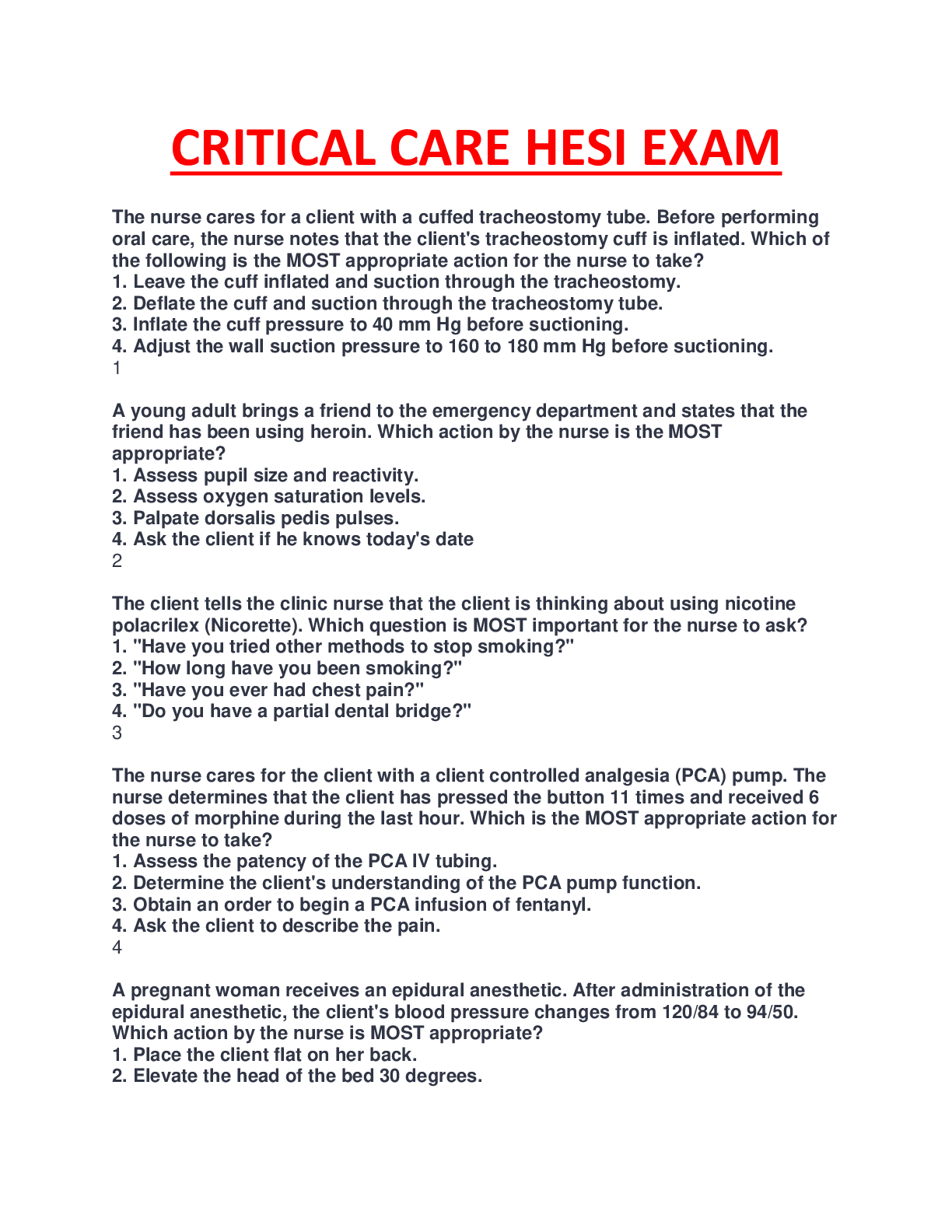
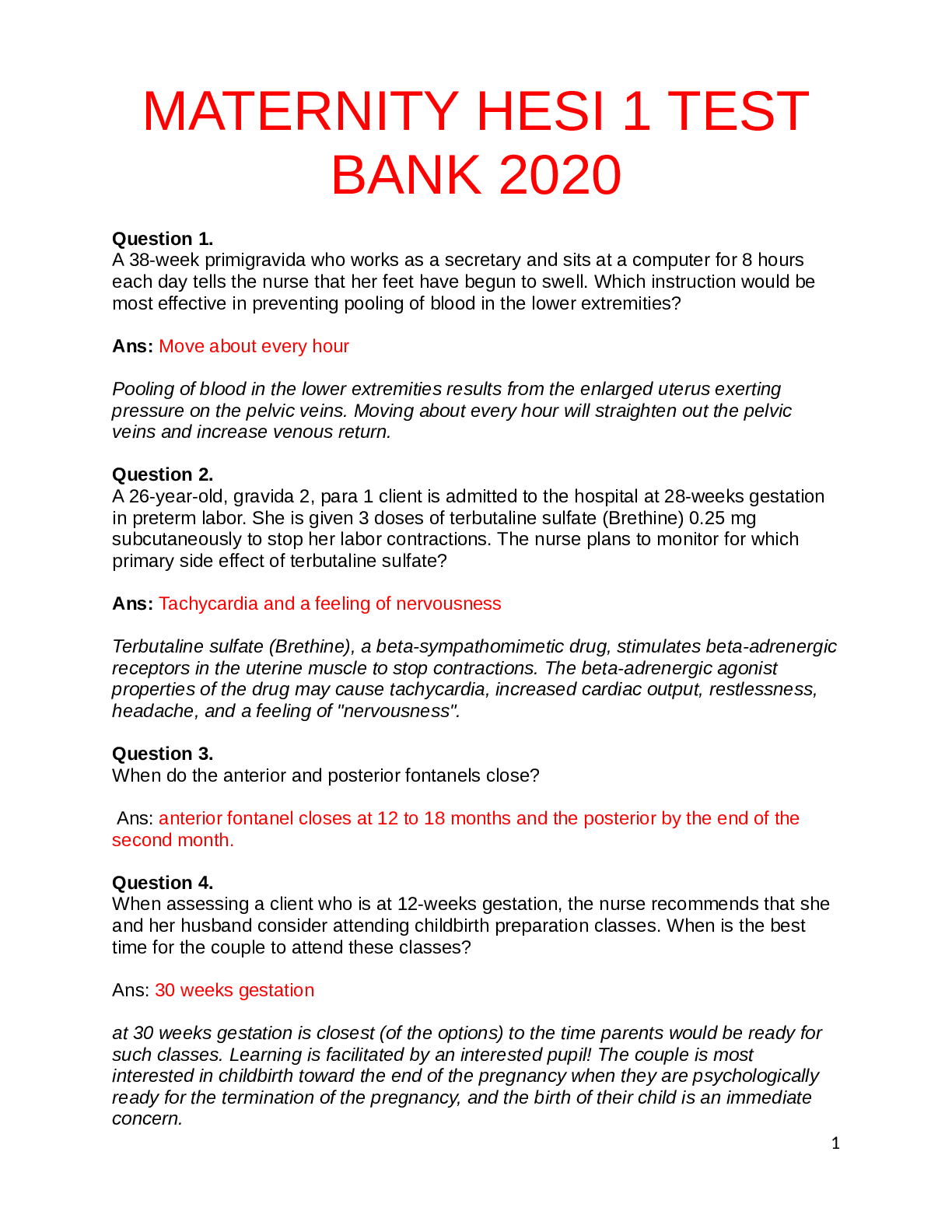
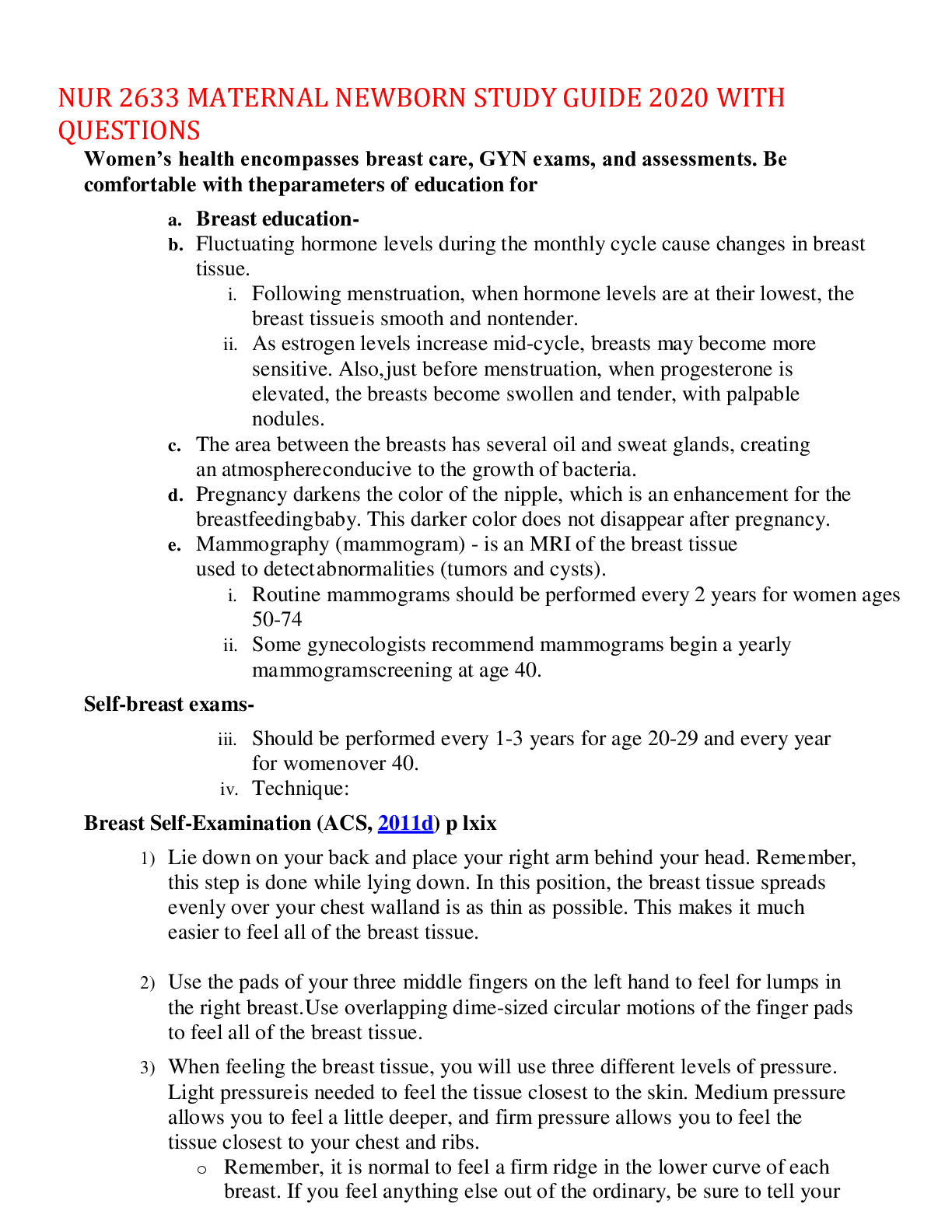


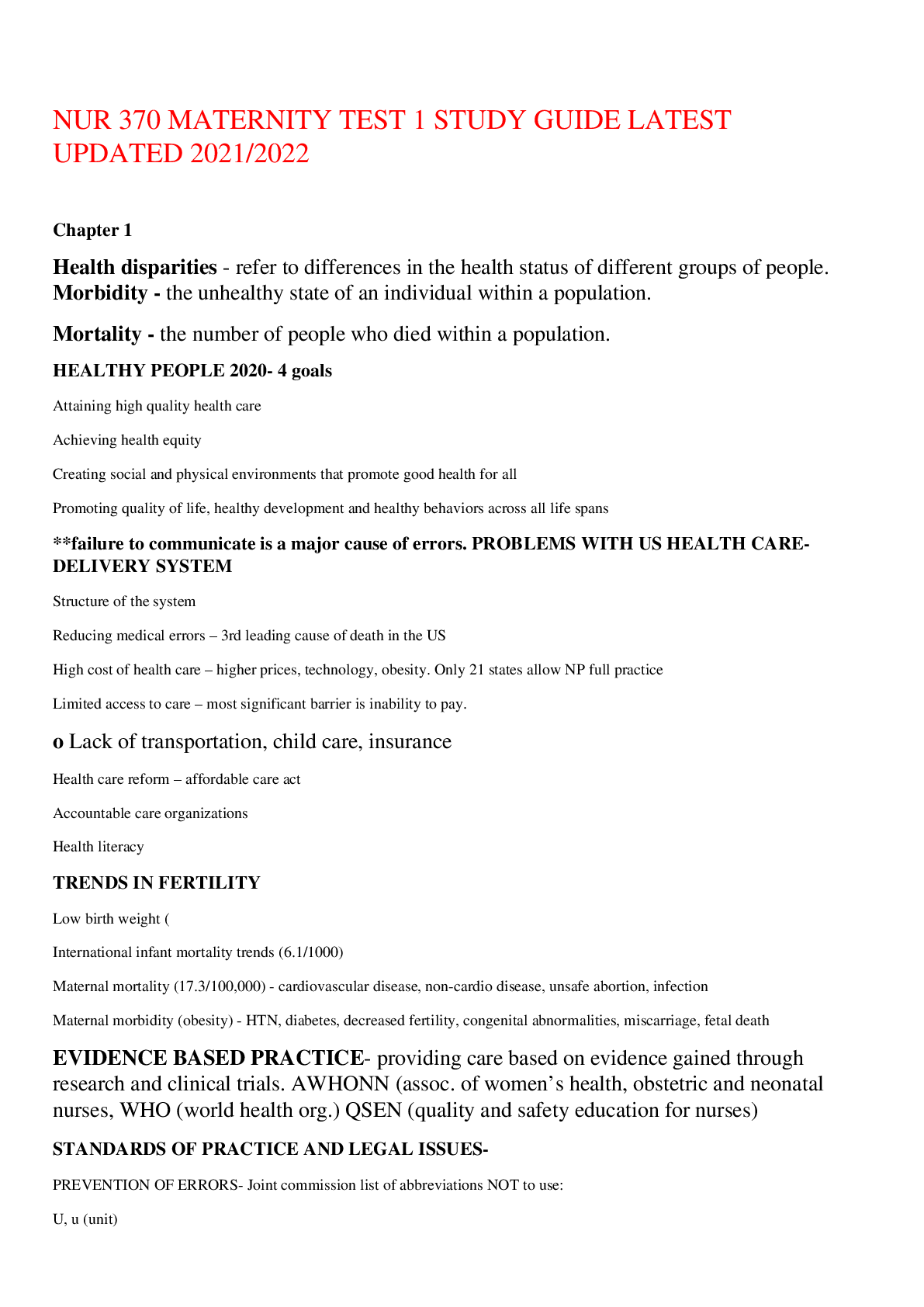
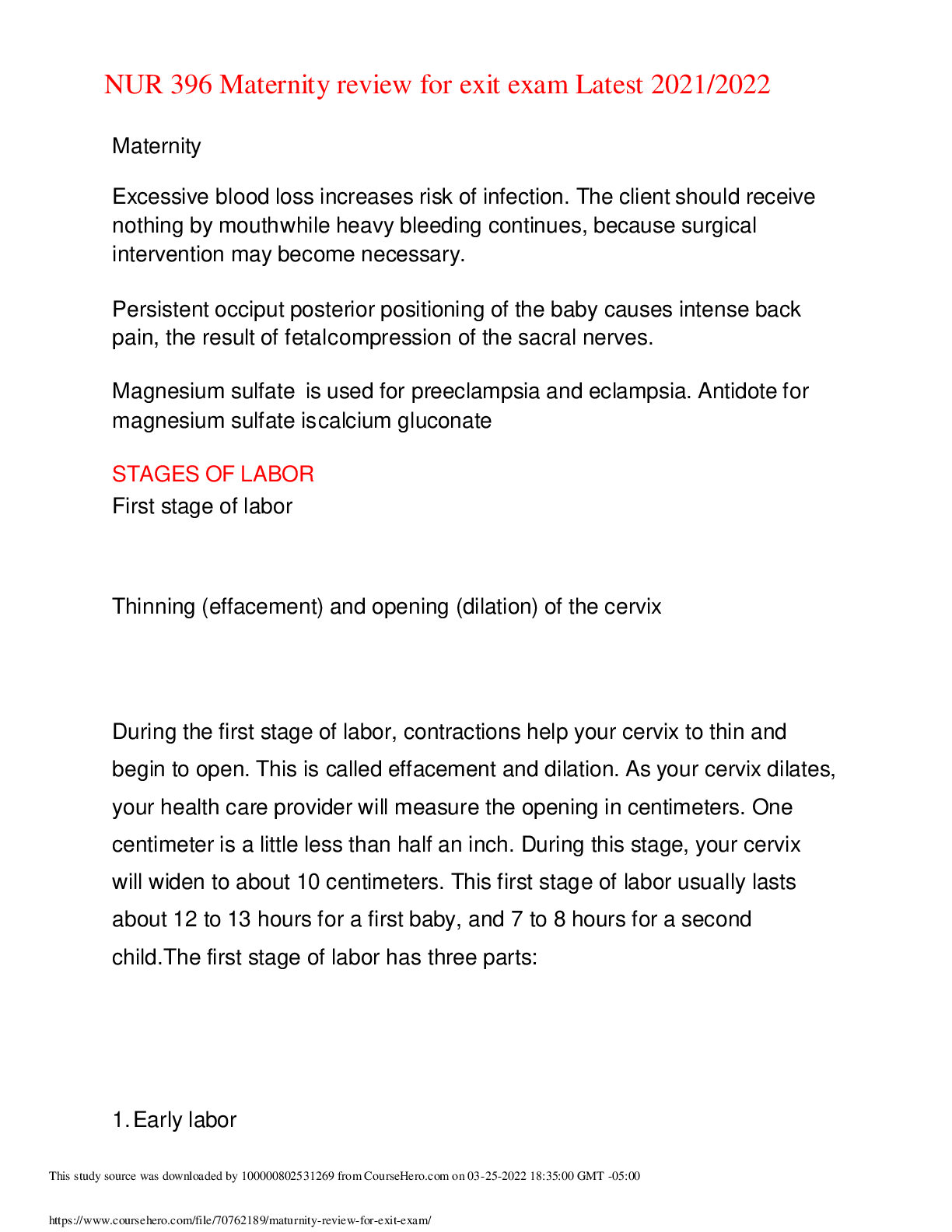

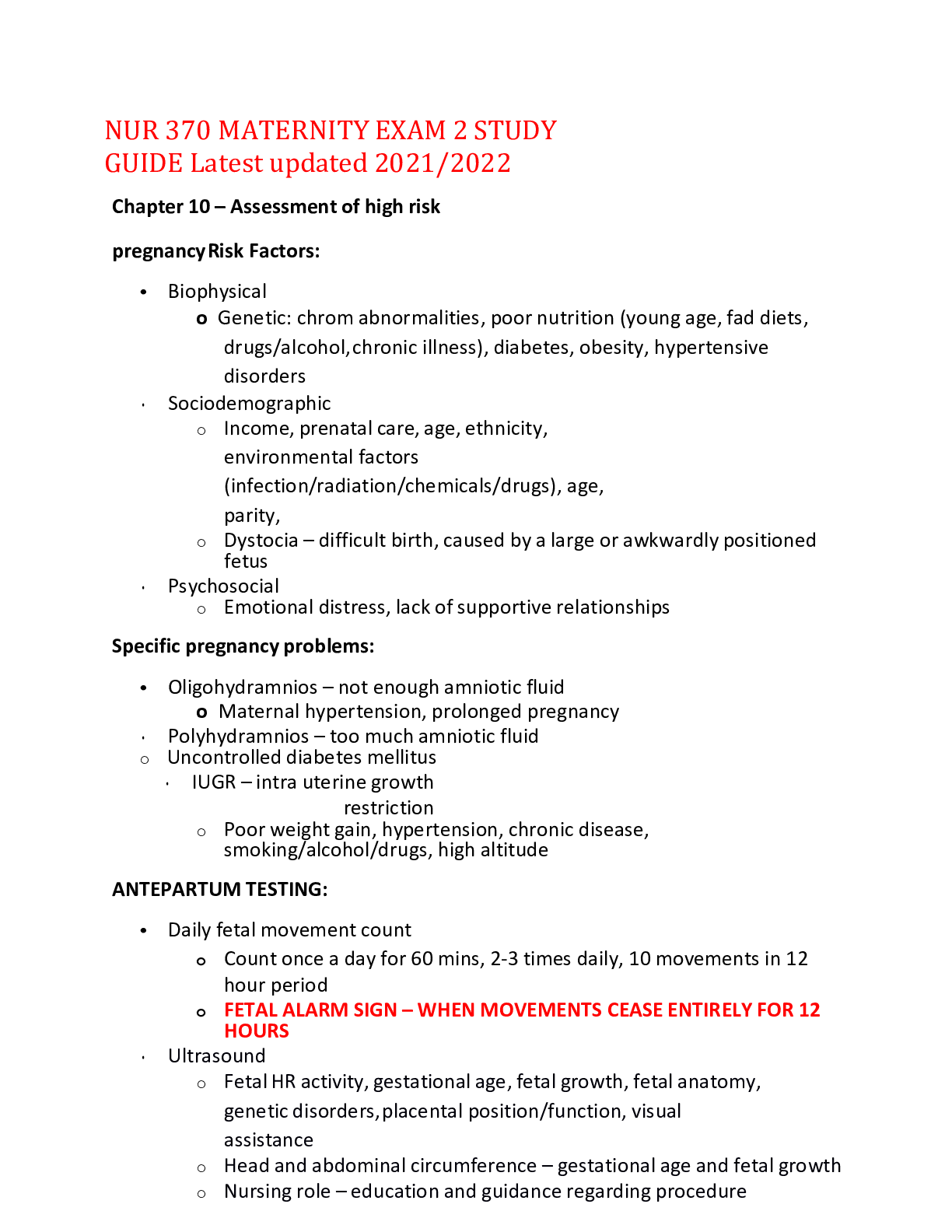
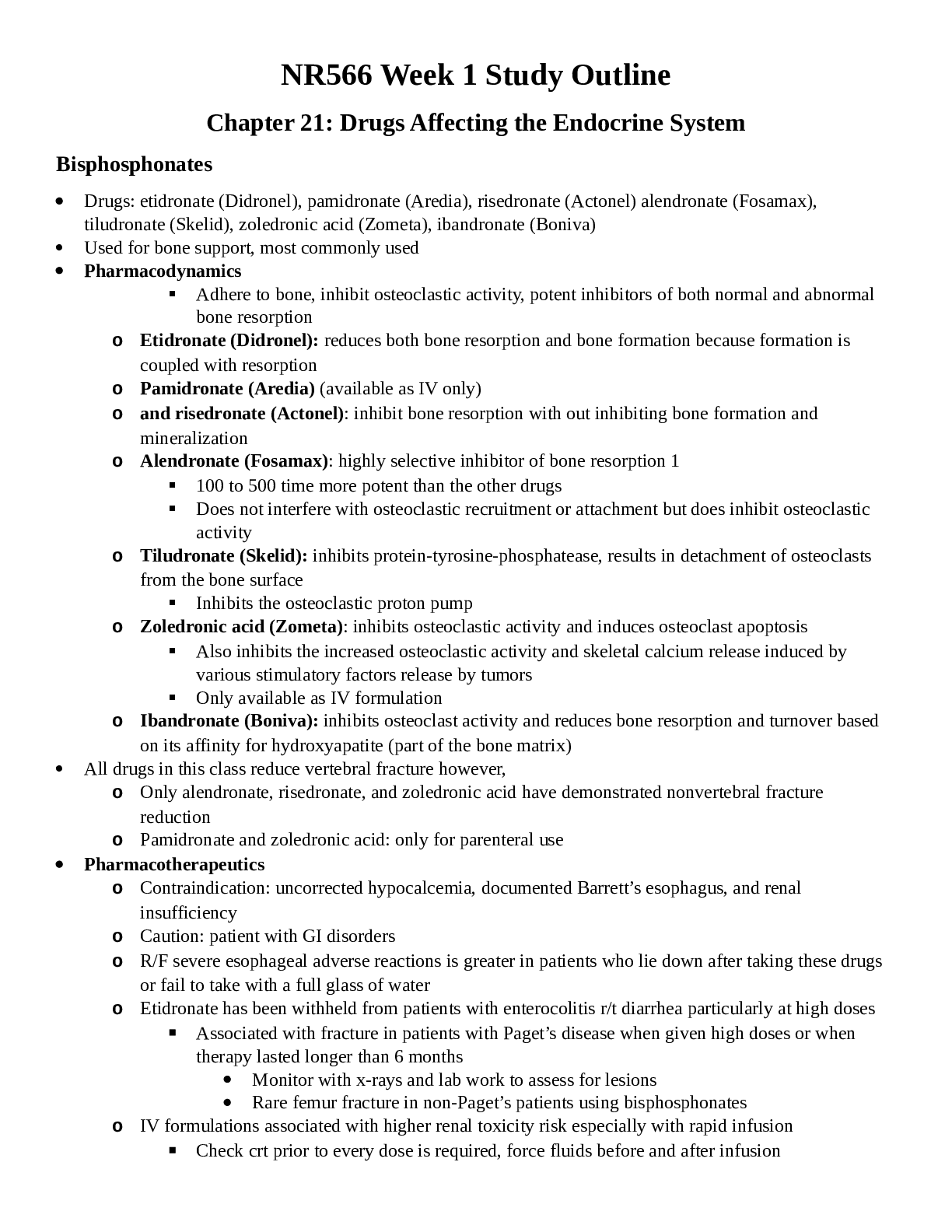
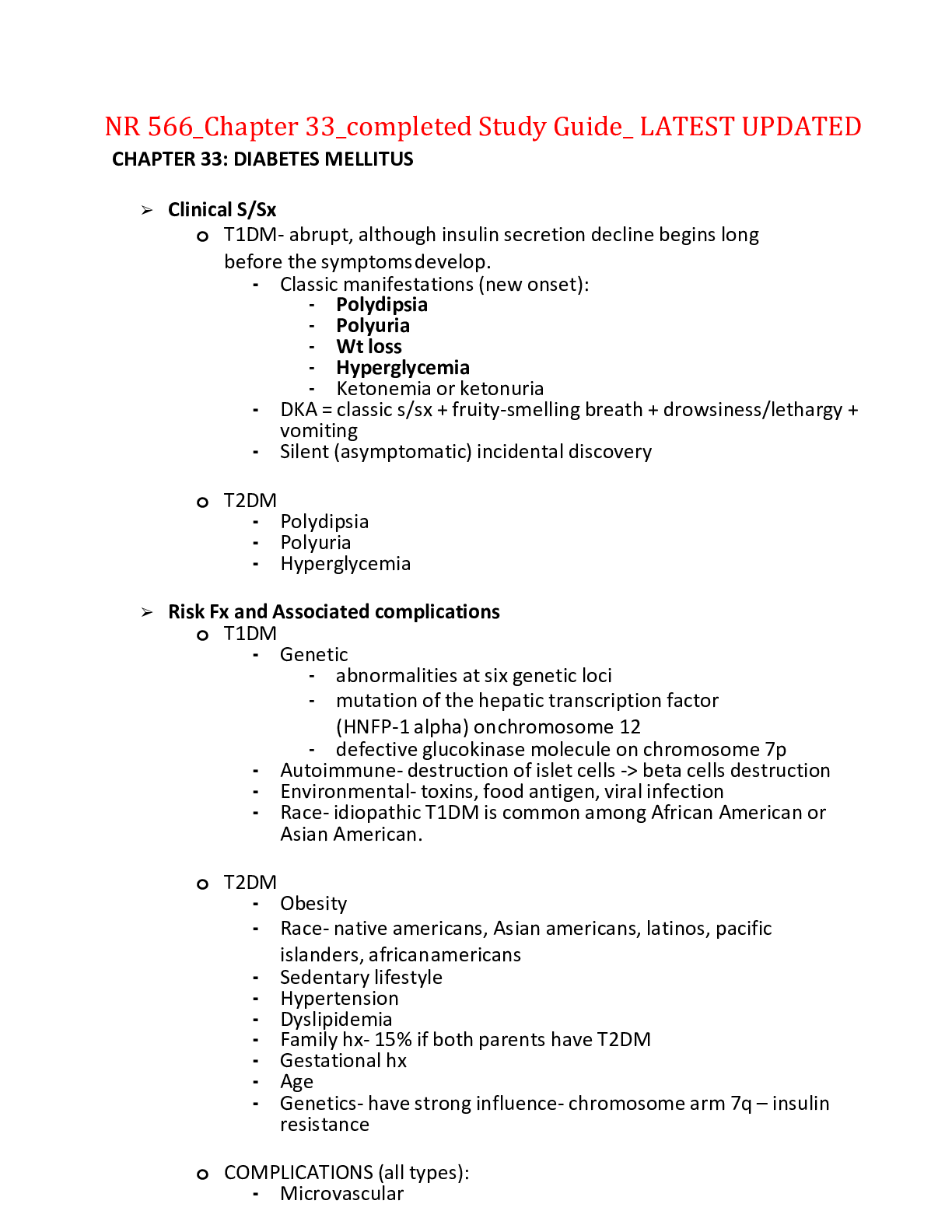

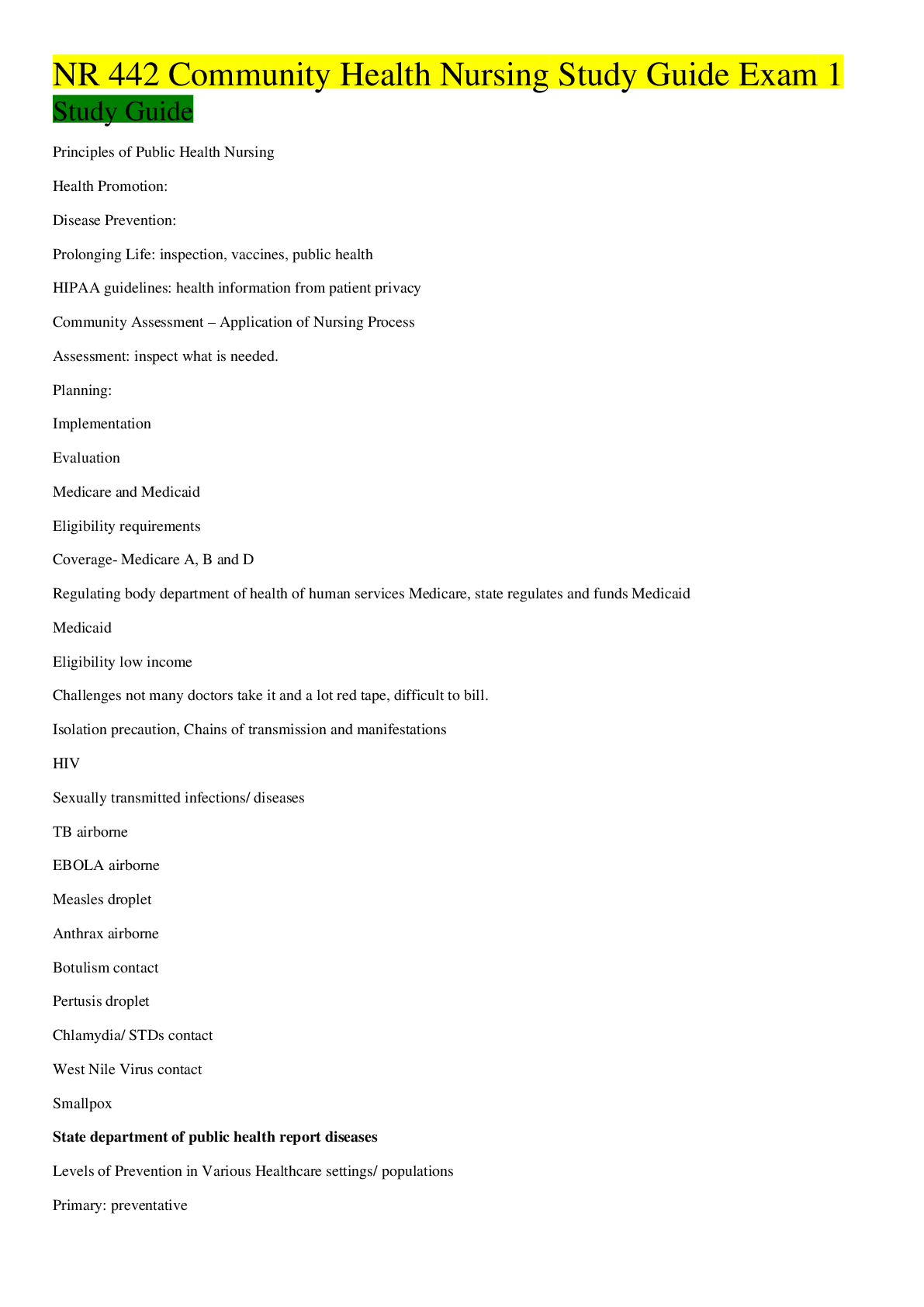
.png)

.png)
